Force ICSE Class-10 Concise Selina Physics Solutions Chapter-1. We Provide Step by Step Answer of Exercise-1(A), MCQs-1(A), Numericals-1(A), Exercise-1(B), MCQ-1(B), Exercise-1(C) and MCQs-1(C) Questions of Exercise-1 Force ICSE Class-10 . Visit official Website CISCE for detail information about ICSE Board Class-10.
| Board | ICSE |
| Publications | Selina Publication |
| Subject | Physics |
| Class | 10th |
| Chapter-1 | Force |
| Book Name | Concise |
| Topics | Solution of Exe-1(A), MCQ 1(A), Numericals 1(A), Exe-1(B), MCQ 1(B), Exe-1(C), MCQ 1(C) |
| Academic Session | 2021-2022 |
Force ICSE Class-10 Concise Selina Physics Solutions Chapter-1
-: Select Exercise :-
Exe-1(A), MCQ 1(A), Numericals 1(A),
Exe-1(B), MCQ 1(B), Exe-1(C), MCQ 1(C)
Moment of force; Forces in Equilibrium; Centre of gravity. Elementary Introduction Of Translation and rotational Motions; Moments of a force, torque and its C.G.S. and S.I. units .Simple Numerical s Problems.
Force ICSE Class-10 Excercise-1(A), Concise Selina Solutions
Page 9
Question 1
State the condition when on applying a force, the body has:
(a) the transnational motion,
(b) the rotational motion.
Answer 1
(a)When the body is free to move it produces translational motion.
(b)When the body is pivoted at a point, it produces rotational motion.
Question 2
Define moment of force and state its S.I. unit.
Answer 2
The moment of force is equal to the product of the magnitude of the force and the perpendicular distance of the line of action of force from the axis of rotation.
S.I. unit of moment of force is Newton metre (N m).
Question 3
State whether the moment of force is a scalar or vector quantity?
Answer 3
Moment of a force is a vector quantity.
Question 4 (Force ICSE Class-10 Concise )
State two factors affecting the turning effect of a force.
Answer 4
Moment of force about a point depends on the following two factors:
(a)The magnitude of the force applied and,
(b)The distance of line of action of the force from the axis of rotation.
Page 10
Question 5
When does a body rotate? State one way to change the direction of rotation of a body. Give a suitable example to explain your answer.
Answer 5
When the body is pivoted at a point, the force applied on the body at a suitable point rotates the body about the axis passing through the pivoted point.
The direction of rotation can be changed by changing the point of application of force. The given figure shows the anticlockwise and clockwise moments produced in a disc pivoted at its centre by changing the point of application of force F from A to B.
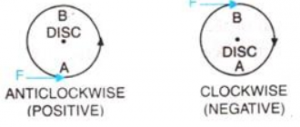
Question 6
Write the expression for the moment of force about a given axis.
Answer 6
Moment of force about a given axis= Force x perpendicular distance of force from the axis of rotation.
Question 7
What do you understand by the clockwise and anticlockwise moment of force? When is it taken positive?
Answer 7
If the turning effect on the body is anticlockwise, moment of force is called anticlockwise moment and it is taken as positive while if the turning effect on the body is clockwise, moment of force is called clockwise moment and is taken negative.
Question 8 (Force ICSE Class-10 Concise )
State one way to reduce the moment of a given force about a given axis of rotation.
Answer 8
Moment of force depends on the distance of line of action of the force from the axis of rotation. Decreasing the perpendicular distance from the axis reduces the moment of a given force.
Question 9
State one way to obtain a greater moment of a force about a given axis of rotation.
Answer 9
Moment of a force is the product of the force and the perpendicular distance of force from axis of rotation. So, one way to increase the moment would be to increase the distance from the axis of rotation where the force would act.
Question 10
Why is it easier to open a door by applying the force at the free end of it?
Answer 10
It is easier to open a door by applying the force at the free end of it because larger the perpendicular distance, less is the force needed to turn the body.
Question 11
The stone of hand flour grinder is provided with a handle near its rim. Give a reason.
Answer 11
The stone of hand flour grinder is provided with a handle near its rim so that it can be rotated easily about the iron pivot at its centre by a small force applied at the handle.
Question 12
It is easier to turn the steering wheel of a large diameter than that of a small diameter. Give reason.
Answer 12
It is easier to turn the steering wheel of a large diameter than that of a small diameter because less force is applied on steering of large diameter which is at a large distance from the centre of rim.
Question 13
A spanner (or wrench) has a long handle. Why?
Answer 13
A spanner (or wrench) has a long handle to produce larger turning moment so that nut can easily be turned with a less force.
Question 14 (Force ICSE Class-10 Concise )
A jack screw is provided with a long arm. Explain why?
Answer 14
A jack screw has a long arm so that less effort is required to rotate it to raise or lower the jack, which is used to lift a heavy load like a vehicle.
Question 15
A, B and C are the three forces each of magnitude 4 N acting in the plane of paper as shown in Figure. The point O lies in the same plane.
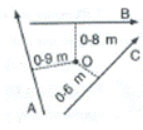
(i) Which force has the least moment about O? Give a reason.
(ii) Which force has the greatest moment about O? Give a reason.
(iii) Name the forces producing (a) clockwise and (b) anticlockwise moments.
(iv) What is the resultant torque about the point O?
Answer 15
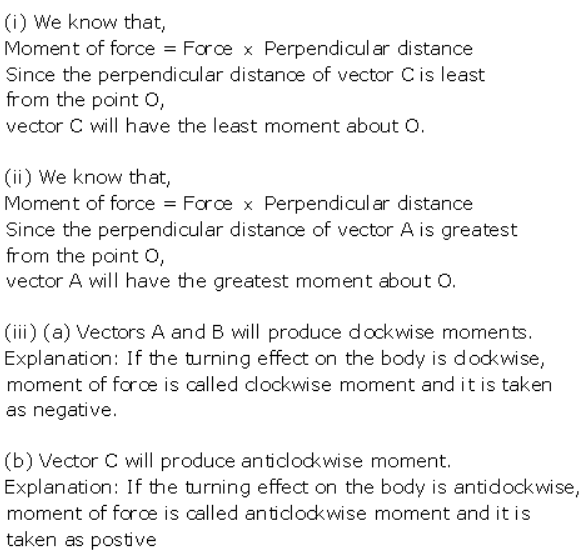
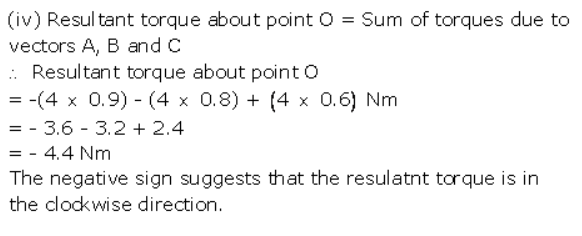
Question 16 (Force ICSE Class-10 Concise )
The adjacent diagram shows a heavy roller, with its axle at O, which is to be raised on a pavement XY. If there is friction between the roller and pavement, show by an arrow on the diagram the point of application and the direction of force to be applied.
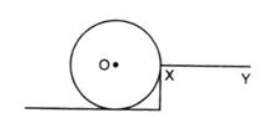
Answer 16
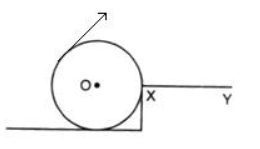
Force F should be provided in the direction as shown in the diagram.
Question 17
A body is acted upon by two forces each of magnitude F, but in opposite directions. State the effect of the forces if
(a)both forces act at the same point of the body.
(b)the two forces act at two different points of the body at a separation r.
Answer 17
(a) Resultant force acting on the body = F-F=0 moment of forces = 0 i.e., no motion of the body
(b) The forces tend to rotate the body about the mid-point between two forces, Moment of forces= Fr
Question 18
Draw a neat labelled diagram to show the direction of two forces acting on a body to produce rotation in it. Also mark the point O about which the rotation takes place.
Answer 18
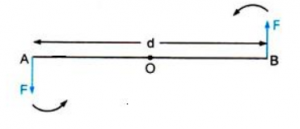
At A and B, two equal and opposite forces each of magnitude F are applied. The two forces rotate the bar in anticlockwise direction.
Question 19
What do you understand by the term couple? State its effect. Give two examples in our daily life where couple is applied to turn a body.
Answer 19
Two equal and opposite parallel forces not acting along the same line, form a couple. A couple is always needed to produce the rotation. For example, turning a key in a lock and turning a steering wheel.
Question 20 (Force ICSE Class-10 Concise )
Define moment of a couple. Write its S.I unit.
Answer 20
The moment of a couple is equal to the product of the either force and the perpendicular distance between the line of action of both the forces. S.I unit of moment of couple is Nm.
Question 21
Prove that
Moment of couple = Force x Couple arm.
Answer 21
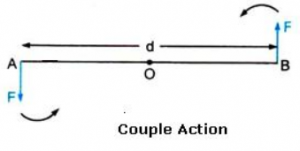
At A and B, two equal and opposite forces each of magnitude F are applied. The two forces rotate the bar in anticlockwise direction. The perpendicular distance between two forces is AB which is called the couple arm.
Moment of force F at the end A
= F x OA (anticlockwise)
Moment of force F at the end B
= F x OB(anticlockwise)
Total moment of couple =F x OA + F x OB
= F x (OA +OB)= F x AB
= F x d(anticlockwise)
=Either force x perpendicular distance between the two forces (or couple arm)
Thus, Moment of couple = Force x Couple arm
Question 22
What do you mean by equilibrium of a body?
Answer 22
When a number of forces acting on a body produce no change in its state of rest or of motion, the body is said to be in equilibrium.
Question 23
State the condition when a body is in (i) static, (ii) dynamic, equilibrium. Give one example each of static and dynamic equilibrium.
Answer 23
(i)When a body remains in the state of rest under the influence of the applied forces, the body is in static equilibrium. For example a book lying on a table is in static equilibrium.
(ii)When a body remains in the same state of motion (translational or rotational), under the influence of the applied forces, the body is said to be in dynamic equilibrium. For example, a rain drop reaches the earth with a constant velocity is in dynamic equilibrium.
Question 24 (Force ICSE Class-10 Concise )
State two conditions for a body, acted upon by several forces to be in equilibrium.
Answer 24
For a body to be in equilibrium:
(i)The resultant of all the forces acting on the body should be equal to zero.
(ii)The resultant moment of all the forces acting on the body about the point of rotation should be zero.
Question 25
State the principle of moments. Name one device based on it.
Answer 25
According to the principle of moments, if the algebraic sum of moments of all the forces acting on the body about the axis of rotation is zero, the body is in equilibrium. A physical balance (or beam balance) works on the principle of moments.
Question 26
Describe a simple experiment to verify the principle of moments, if you are supplied with a metre rule, a fulcrum and two springs with slotted weights.
Answer 26
Suspend a metre rule horizontally from a fixed support by means of a strong thread at O as shown. Now suspend two spring balances with some slotted weights W1 and W2 on them on either side of the thread. The scale may tilt to one side. Now adjust the distances of two spring balances from the support by keeping one at A and the other at B in such a way that the scale again becomes horizontal.
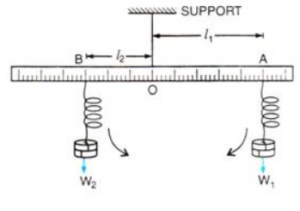
Let the weight suspended on the right side of thread from the spring balance at A be W1 at distance OA=l1, while the weight suspended on the left side of thread from the spring balance at B be W2 at distance OB= l2.
The weight W1 tends to turn the scale clockwise, while the weight W2 tend to turn the scale anticlockwise.
Clockwise moment = W1 x l1
Anticlockwise moment = W2 x l2
In equilibrium, when the scale is horizontal, it is found that
Clockwise moment = Anticlockwise moment
i.e.,W1 x l1 = W2 x l2
This verifies the principle of moments.
Question 27
Complete the following sentences:
(i) The S.I. unit of moment of force is _________.
(ii) In equilibrium algebraic sum of moments of all forces about the point of rotation is ______________.
(iii) In a beam balance when the beam is balanced in a horizontal position, it is in ____________equilibrium.
(iv) The moon revolving around the earth is in ____________ equilibrium.
Answer 27
(i) The S.I. unit of moment of force is newton-metre.
(ii) In equilibrium algebraic sum of moments of all forces about the point of rotation is zero.
(iii) In a beam balance when the beam is balanced in a horizontal position, it is in static equilibrium.
(iv) The moon revolving around the earth is in dynamic equilibrium.
MCQs -1 (A) Concise Physics Solutions Force
Page 10
Question 1
The moment of a force about a given axis depends:
(a) Only on the magnitude of force
(b) Only on the perpendicular distance of force from the axis
(c) Neither on the force nor on the perpendicular distance of force from the axis
(d) On both the force and its perpendicular distance from the axis.
Answer 1
The moment of a force about a given axis depends on both on the force and its perpendicular distance from the axis.
Page 11
Question 2
A body is acted upon by two unequal forces in opposite directions, but not in same line. The effect is that
(a) The body will have only the rotational motion
(b) The body will have only the translational motion
(c) The body will have neither the rotational motion nor the translational motion
(d) The body will have rotational as well as translational motion.
Answer 2
(d) The body will have rotational as well as translational motion.
NUMERICALS- 1 (A) ICSE Class-10 Force
Page 11
Question 1
The moment of a force of 10 N about a fixed point O is 5 Nm. Calculate the distance of the point O from the line of action of the force.
Answer 1
Moment of force= force x perpendicular distance of force from point O
Moment of force= F x r
5 Nm= 10 x r
R= 5/10 =0.5 m
Question 2
A nut is opened by a wrench of length 10cm. If the least force required is 5.0N, find the moment of force needed to turn the nut.
Answer 2
Length, r=10 cm =0.1 m
F= 5N
Moment of force= F x r= 5 x 0.1= 0.5 Nm
Question 3 (Force ICSE Class-10 Concise )
A wheel of diameter 2 m is shown in Fig. 1.28 with axle at O. A force F = 2 N is applied at B in the direction shown in figure. Calculate the moment of force about (i) the centre O, and (ii) the point A.
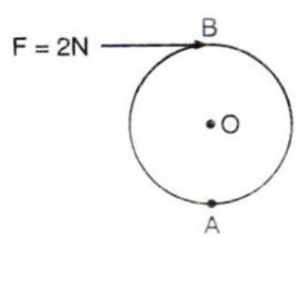
Answer 3
Given , F= 2 N
Diameter=2 m
Perpendicular distance between B and O =1 m
(i)Moment of force at point O
= F x r
=2 x 1=2 Nm (clockwise)
(ii)Moment of force at point A= F x r
=2 x 2= 4 Nm (clockwise)
Question 4
The diagram in Fig. 1.29 shows two forces F1= 5N and F2 = 3N acting at points A and B of a rod pivoted at a point O, such that OA = 2m and OB = 4 m
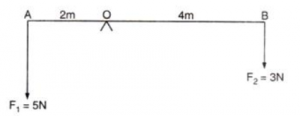
Calculate:
(i) the moment of force F1 about O.
(ii) the moment of force F2 about O.
(iii) total moment of the two forces about O.
Answer 4
Given AO=2 m and OB=4 m
(i)Moment of force F1(=5N) at A about the point O
=F1 x OA
=5 x 2= 10Nm (anticlockwise)
(ii)Moment of force F2(=3N) at B about the point O
= F2 x OB
=3 x 4=12 Nm(clockwise)
(iii)Total moment of forces about the mid-point O=
= 12- 10=2Nm(clockwise)
Question 5 (Force ICSE Class-10 Concise )
Two forces each of magnitude 10 N act vertically upwards and downwards respectively at the two ends A and B of a uniform rod of length 4 m which is pivoted at its mid-point O as shown. Determine the magnitude of resultant moment of forces about the pivot O.
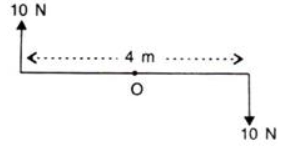
Answer 5
Given, AB=4 m hence, OA=2 m and OB =2 m
Moment of force F(=10 N) at A about the point O
= F x OA= 10 x 2= 20 Nm (clockwise)
Moment of force F (=10N) at point B about the point O
= F x OB= 10 x 2 =20Nm (clockwise)
Total moment of forces about the mid-point O=
=20 +20= 40 Nm (clockwise)
Question 6
Figure shows two forces each of magnitude 10 N acting at the points A and B at a separation of 50 cm, in opposite directions. Calculate the resultant moment of the two forces about the point (i) A, (ii) B and (iii) O, situated exactly at the middle of the two forces.
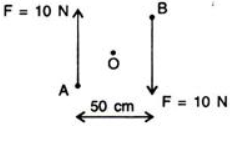
Answer 6
(i)Perpendicular distance of point A from the force F=10 N at B is 0.5 m , while it is zero from the force F=10 N at A
Hence, moment of force about A is
= 10 N x 0.5 m=5 Nm(clockwise)
(ii)Perpendicular distance of point B from the force F=10 N at A is 0.5 m, while it is zero from the force F=10N at B
Hence, moment of force about B is
= 10 N x 0.5m =5 Nm(clockwise)
(iii)Perpendicular distance of point O from either of the forces F=10N is 0.25 m
Moment of force F(=10 N) at A about O= 10N x 0.25 m
=2.5Nm(clockwise)
And moment of force F(=10N) at B about O
=10N x 0.25m=2.5Nm(clockwise)
Hence, total moment of the two forces about O
=0.25 + 0.25=5Nm (clockwise)
Question 7
A steering wheel of diameter 0.5 m is rotated anti-clockwise by applying two forces each of magnitude 5 N. Draw a diagram to show the application of forces and calculate the moment of forces applied.
Answer 7

Moment of couple = either force x couple arm
= 5 N x 0.5 m
=2.5 Nm
Question 8 (Force ICSE Class-10 Concise )
A uniform metre rule is pivoted at its mid-point. A weight of 50gf is suspended at one end of it. Where a weight of 100gf should be suspended to keep the rule horizontal?
Answer 8
Let the 50 gf weight produce anticlockwise moment about the middle point of metre rule .i.e, at 50 cm.and Let a weight of 100 gf produce a clockwise moment about the middle point. Let its distance from the middle be d cm. Then,
according to principle of moments,
Anticlockwise moment = Clockwise moment
50 gf x 50 cm=100 gf x d
So, d=
Question 9
A uniform metre rule balances horizontally on a knife edge placed at the 58 cm mark when a weight of 20 gf is suspended from one end.
(i)Draw a diagram of the arrangement.
(ii)What is the weight of the rule?
Answer 9
(i)Weight mg (W) of rule produces an anti-clockwise moment about the knife edge O. In order to balance it, 20 gf must be suspended at the end B to produce clockwise moment about the knife edge O.
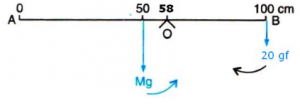
(ii) From the principle of moments,
Anticlockwise moment= Clockwise moment
W x (58-50) =20 gf x (100-58)
=W x 8=20 gf x 42
W = 
Question 10
The diagram below shows a uniform bar supported at the middle point O. A weight of 40gf is placed at a distance 40 cm to the left of the point O. How can you balance the bar with a weight of 80 gf?

Answer 10
Anticlockwise moment= 40 gf x 40 cm
Clockwise moment= 80 gf x d cm
From the principle of moments,
Anticlockwise moment= Clockwise moment
40 gf x 40 cm =80 gf x d
So, d = ![]()
Question 11
Figure shows a uniform metre rule placed on a fulcrum at its mid-point O and having a weight 40 gf at the 10 cm mark and a weight of 20 gf at the 90 cm mark. (i) Is the metre rule in equilibrium? If not, how will the rule turn? (ii) How can the rule be brought in equilibrium by using an additional weight of 40 gf?

Answer 11
(i) Anticlockwise moment= 40 gf x (50-10)cm
=40 gf x 40 cm=1600 gf x cm
Clockwise moment= 20 gf x (90- 50) =20 gf x 40 cm
=800 gf x cm
Anticlockwise moment is not equal to clockwise moment. Hence the metre rule is not in equilibrium and it will turn anticlockwise.
(ii)To balance it, 40gf weight should be kept on right hand side so as to produce a clockwise moment about the middle point. Let its distance from the middle be d cm. Then,
clockwise moment= 20 gf x 40 cm + 40 gf x d cm
From the principle of moments,
Anticlockwise moment= Clockwise moment
40 gf x 40 cm= 20 gf x 40 + 40 x d cm
1600-800=40 gf x dcm
So, d= (on the other side)
Hence, by placing the additional weight of 40 gf at the 70 cm mark the rule can be brought in equilibrium.
Page 12
Question 12
When a boy weighing 20 kgf sits at one end of a 4m long see-saw, it gets depressed at its end. How can it be brought to the horizontal position by a man weighing 40 kgf.
Answer 12
From the principle of moments,
Anticlockwise moment= Clockwise moment
20 kgf x 2m =40 kgf x d
So, d= from the centre on the side opposite to the boy.
Question 13 (Force ICSE Class-10 Concise )
A physical balance has its arms of length 60 cm and 40 cm. What weight kept on a pan of longer arm will balance an object of weight 100 gf kept on other pan?
Answer 13
From the principle of moments,
Anticlockwise moment= Clockwise moment
100 gf x 40 cm =W x 60 cm
So, weight on the longer pan ,

Question 14
The diagram in shows a uniform metre rule weighing 100 gf, pivoted at its centre O. Two weights 150 gf and 250 gf hang from the point A and B respectively of the metre rule such that OA = 40 cm and OB = 20 cm. Calculate: (i) the total anticlockwise moment about O, (ii) the total clockwise moment about O, (iii) the difference of anticlockwise and clockwise moment, and (iv) the distance from O where a 100 gf weight should be placed to balance the metre rule.
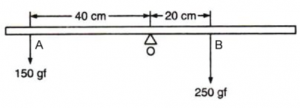
Answer 14
(i)Total anticlockwise moment about O
= 150 gf x 40 cm=6000 gf cm
(ii)Total clockwise moment about O,
=250 gf x 20 cm= 5000 gf cm
(iii) The difference of anticlockwise and clockwise moment= 6000- 5000= 1000 gf cm
(iv) From the principle of moments,
Anticlockwise moment= Clockwise moment
To balance it, 100 gf weight should be kept on right hand side so as to produce a clockwise moment about the O. Let its distance from the point O be d cm. Then,
150 gf x 40 cm=250 gf x 20 cm +100 gf x d
6000 gf cm= 5000 gf cm + 100 gf x d
1000gf cm =100 gf x d
So, d=  on the right side of O.
on the right side of O.
Question 15
A uniform metre rule of weight 10 gf is pivoted at its 0 mark.
(i) What moment of force depresses the rule?
(ii) How can it be made horizontal by applying a least force?
Answer 15
(i)Anticlockwise moment= 10 gf x 50 cm= 500 gf cm
(ii)From the principle of moments,
Anticlockwise moment= Clockwise moment
10 gf x 50 cm= W x 100 cm
So, W= 
By applying a force 5 gf upwards at the 100 cm mark, rule can be made horizontal.
Question 16 (Force ICSE Class-10 Concise )
A uniform half metre rule can be balanced at the 29.0 cm mark when a mass 20 g is hung from its one end.
(a) Draw a diagram of the arrangement.
(b) Find the mass of the half metre rule.
(c) In which direction would the balancing point shift-if 20 g mass is shifted inside from its one end ?
Answer 16
(a)
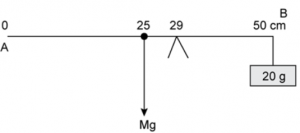
Figure shows a uniform half metre rule PQ which is balanced at 29 cm mark. Let M be the mass of the rule. A uniform rule has same distribution of mass throughout its length So its weight Mg will act at its middle point which is at 25 cm. The weight mg produces anticlockwise moment about point o. In order to balance the 20 g (0.02kg) weight is tied at 50 cm mark which generates clockwise moment.
(b) Hence from the principle of moments
Anticlockwise moment= clockwise moment
Mg(29-25)=0.02 g(50-29)
M=21(0.02)/4
M=0.105 kg
M=105 g
(c) Towards 25 cm mark
Question 17
A uniform metre rule of mass 100 g is balanced on a fulcrum at mark 40 cm by suspending an unknown mass m at the mark 20 cm.
(i) find the value of m.
(ii) To which side the rule will tilt if the mass m is moved to the mark 10 cm?
(iii) What is the resultant moment now?
(iv) How can it be balanced by another mass 50 g?
Answer 17
(i) From the principle of moments,
Clockwise moment= Anticlockwise moment
100 g x (50-40) cm= mx (40-20) cm
100 g x 10 cm = m x 20 cm = m =50 g
(ii)The rule will tilt on the side of mass m (anticlockwise), if the mass m is moved to the mark 10 cm.
(iii)Anticlockwise moment if mass m is moved to the mark 10 cm= 50g x (40-10)cm =50 x 30=1500 g cm
Clockwise moment=100 g x (50-40) cm= 1000 g cm
Resultant moment= 1500 g cm -1000 g cm= 500 g cm (anticlockwise)
(iv) From the principle of moments,
Clockwise moment= Anticlockwise moment
To balance it, 50 g weight should be kept on right hand side so as to produce a clockwise moment .Let its distance from fulcrum be d cm. Then,
100g x (50-40) cm + 50g x d =50g x (40-10)cm
1000g cm + 50g x d =1500 g cm
50 g x d= 500g cm
So, d =10 cm
By suspending the mass 50 g at the mark 50 cm, it can be balanced.
Question 18
In figure below, a uniform bar of length l m is supported at its ends and loaded by a weight W kgf at its middle. In equilibrium, find the reactions R1 and R2 at the ends.
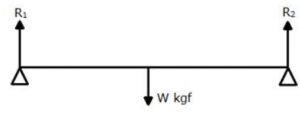
Answer 18
According to the principle of moments,
Clockwise moments = anticlockwise moments
As the s![]()
System is in equilibrium,
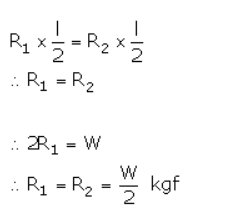
Return to Concise Selina ICSE Physics Class-10
Thanks
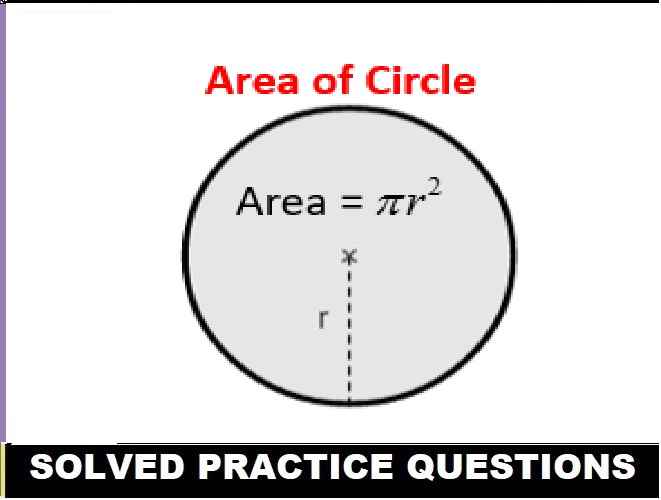

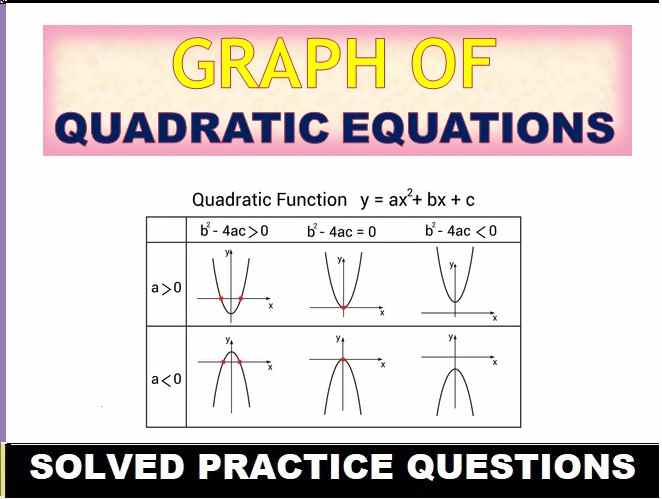
Tnx a lot .It is most valuable for me
Thanks Dear
Thanks VERY MUCH. I got my Answers from it.
ok